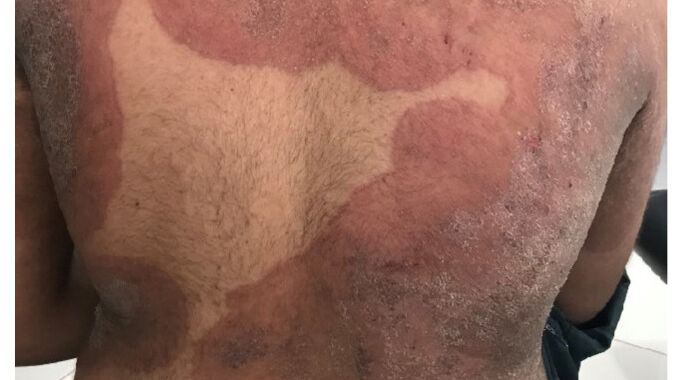A dermatologist in New York City has reported the country’s first known cases of highly contagious ringworm infections that are resistant to common anti-fungal treatments—and caused by a newly emerging fungus that is rapidly outstripping other infectious fungi around the world.
In February, the dermatologist reported two cases to health officials in the state, which are described in a brief case study published Thursday in the Centers for Disease Control and Prevention’s Morbidity and Mortality Weekly Report.
The two cases occurred a year apart and had no connection to each other. The first, from the summer of 2021, was in a 28-year-old pregnant woman who had no recent international travel history, no underlying medical conditions, and no known contact with anyone who had a similar rash. The case suggests that the fungus is quietly spreading in the community.
Ringworm—aka tineas, dermatophytosis, jock itch, and athlete’s foot—is a superficial fungal infection of the skin that causes red, itchy, sometimes scaly circular rashes. There are more than 40 different species of fungi that can cause the infection, which spreads from infected people and animals and also lurks in environments and on common household items, like towels. Ringworm is extremely common and can strike anyone. Usually, it’s treatable with over-the-counter creams.
But, in the 28-year-old’s case, her 2021 infection was only finally cured in early 2022, after the birth of her baby, after first-line treatment failed and she underwent a four-week course of an oral anti-fungal medicine, itraconazole.
The second case occurred in the summer of 2022 in a 47-year-old woman during a trip to Bangladesh. There, she received a common topical antifungal and steroid combination, but it didn’t help. Back in the US, she went to the emergency department three times during the fall of 2022 for her infection, each time getting common anti-fungal treatments that didn’t work. In December 2022, she saw a dermatologist who prescribed a four-week oral course of terbinafine, a common first-line anti-fungal. But it didn’t work. She next tried a four-week course of griseofulvin, which is sometimes used to treat tinea on the scalp. It only resulted in about 80 percent improvement. At the time the case study was written, the woman was being considered for another round of treatment, possibly itraconazole. The woman’s husband and son were also reported to have similar skin infections and were being evaluated.
Global scourge
While alarming, the identification of cases in the US is not surprising. The fungus behind the infections is Trichophyton indotineae (previously described as Trichophyton mentagrophytes type VIII), which is a newly emerging fungus globally. Though genetic studies date isolates back to at least 2008 in Australia, a multidrug-resistant lineage seemed to erupt in India between 2017 and 2018. Since then, it has reached epidemic proportions in the subcontinent, replacing other common causes of ringworm, and the pathogen has rapidly emerged in many countries throughout Asia and Europe, and Canada.
In the US cases, common lab tests don’t distinguish T. indotineae from other species, and both cases were first identified as being caused by T. mentagrophytes. It wasn’t until sufficient suspicion was raised in March 2023 that isolates from both cases were genetically sequenced, conclusively identifying T. indotineae.
Although ringworm infections are not considered life-threatening, drug-resistant forms can spread over large swaths of the body, potentially establishing chronic or recurring intensely itchy infections. In the young pregnant woman’s case, the rash covered her neck, abdomen, pubic region, and buttocks. In the older woman’s case, the uncomfortable plaques covered her thighs and buttocks. Such rashes can cause extreme discomfort, social stigma, and lower quality of life. Complications of ringworm infections can include secondary bacterial infections and, in rare cases, infections that reach deeper into the skin that can be serious.
The rise of T. indotineae is linked to the abuse of topical treatments that contain egregiously large combinations of steroids and antifungal/antibacterial agents, spurring the development of resistance. This is particularly a problem in India.
As New York and CDC health officials note in the MMWR case study, “Antimicrobial stewardship efforts are essential to minimize the misuse and overuse of prescribed and over-the-counter antifungal drugs and corticosteroids.” The authors called for clinicians to look for resistant ringworm cases, as clinical testing can misidentify the fungus.
Tips to try to avoid the infection include basic hygiene like daily baths and changing your socks and underwear daily, plus avoiding tight shoes that make your feet sweat, showering after contact sports, and washing your hands after playing with pets.


